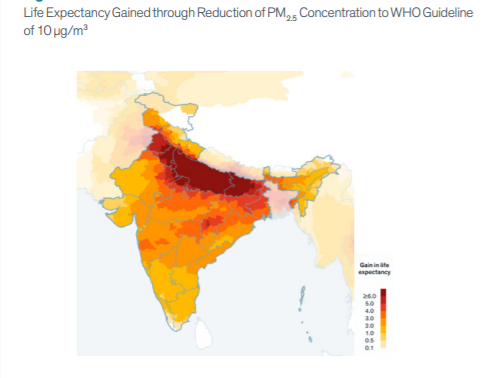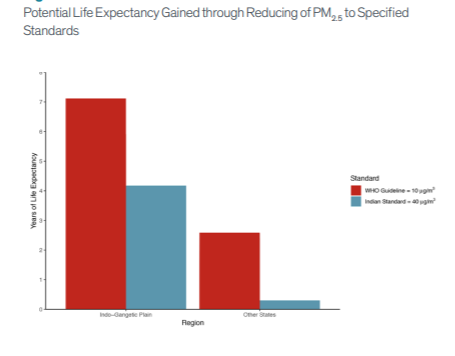SDG 3: Air pollution 3 times deadlier in North India, cutting lives by 7 years
While air pollution is a challenge throughout much of India, the high levels of particulate pollution in the IGP region of the North India, which includes Bihar, Chandigarh, Delhi, Haryana, Punjab, Uttar Pradesh and West Bengal, stand out.

- Country:
- India
A new analysis of the Air Quality Life Index (AQLI), produced by the Energy Policy Institute at the University of Chicago (EPIC), shows the average citizen living in the Indo-Gangetic Plain (IGP) region of India can expect to lose about 7 years of life expectancy because air quality fails to meet the World Health Organization’s (WHO) guideline for fine particulate pollution.
According to the report, there has been 72 percent increase in pollution from 1998 to 2016 in the region that is home to about 40 percent of India’s population. "In 1998, the impact on people’s lives would have been half of what it is today, with residents losing 3.7 years of life expectancy," said the report.
While air pollution is a challenge throughout much of India, the high levels of particulate pollution in the IGP region of the North India, which includes Bihar, Chandigarh, Delhi, Haryana, Punjab, Uttar Pradesh and West Bengal, stand out. In 1998, citizens living outside of the IGP region would have seen their lives cut short by 1.2 years relative to what it would have been if air quality met the WHO guideline. That number has grown to 2.6 years—also worsening but much more modest than what has taken place in the IGP.

The findings were announced as the full platform of the AQLI was made accessible in Hindi language as well, expanding the Index’s ability to inform citizens and policymakers about particulate air pollution—the greatest threat to human health globally. The Hindi is the national language of India which is spoken by maximum number of people and dominates the Northern Region of the country i.e. area between Himalayas and Vindyachal ranges.
“With the addition of this Hindi version, hundreds of millions more users will be able to learn how particulate pollution is affecting their lives, and, importantly, how air pollution policies can make an enormous difference in increasing life expectancy,” said Michael Greenstone, the Milton Friedman Distinguished Service Professor in Economics and director of Energy Policy Institute at the University of Chicago (EPIC). If India is successful in meeting its goals under the National Clean Air Programme (NCAP), and sustaining pollution reductions of about 25 percent, the AQLI shows that such improvements in air quality would extend the life expectancy of the average Indian by 1.3 years. Those in the IGP would gain about 2 years onto their lives.
Speaking at the Hindi AQLI launch event in New Delhi on 31st October, Shri Gaurav Gogoi, Member of Parliament and World Economic Forum, Young Global Leader said, “I am working towards introducing a private member's bill to come up with a new Clean Air (Amendment) Act where health impacts of air pollution is given the top priority. Its high time that we as policymakers use evidence based data to formulate policies that clean up our skies and help our citizens live longer and healthier lives.”
The AQLI is rooted in a pair of peer-reviewed studies in which Greenstone and his co-authors exploited a unique natural experiment in China based on China’s Huai River Winter Heating policy. The natural experiment allowed them to isolate the effect of air pollution from other factors that affect health, and to do so at the very high concentrations that prevail in India and other countries today. They then combined the results from these studies with hyper-localized, global particulate matter measurements, allowing users to zoom in on any district in the world and understand the impacts of that district’s local air pollution on life expectancy.
(With inputs from EPIC)
ALSO READ
World Bank-Sweden report reveals poverty and distributional impacts of air pollution in Tbilisi
Awareness about air pollution-related terminologies low among urban poor in Delhi-NCR: Study
"100 Women Artists Use Madhubani Art to Illustrate the Epic Ramayana on Canvas"
Epic 3-3 draw between Real Madrid and Man City in Champions League quarterfinals at Bernabeu
100 Madhubani paintings by women-artists depict Ramayan on canvas










